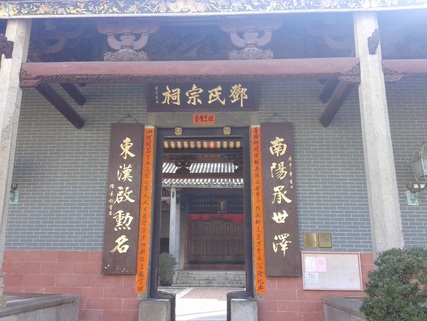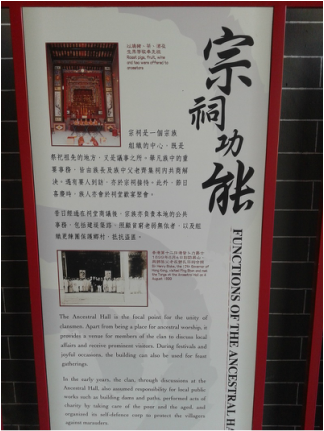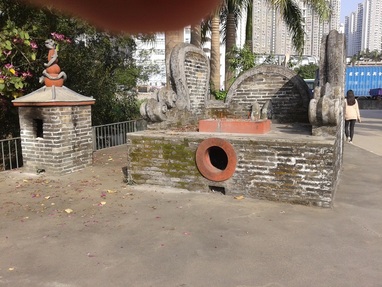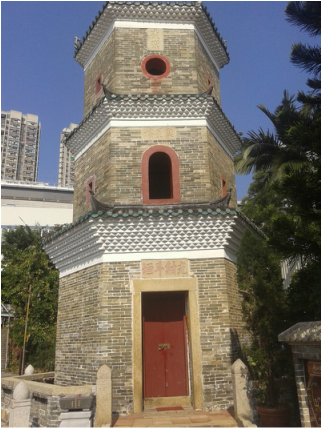Ping Shan Heritage Trail

They have settled in Ping Shan for more than 800 years.
They established “Three Wais (walled villages) and Six Tsuens (villages)” - Sheung Cheung Wai, Kiu Tau Wai and Fui Sha Wai, and Hang Tau Tsuen, Hang Mei Tsuen, Tong Fong Tsuen, San Tsuen, San Hei Tsuen and Hung Uk Tsuen.
They also erected some traditional Chinese buildings, such as ancestral halls, temples, study halls and pagoda, for ancestral worship and education.
Thus, it is interesting to visit there as you can find some traditional and unique characteristics of the culture of Hong Kong's New Terriorties.
They established “Three Wais (walled villages) and Six Tsuens (villages)” - Sheung Cheung Wai, Kiu Tau Wai and Fui Sha Wai, and Hang Tau Tsuen, Hang Mei Tsuen, Tong Fong Tsuen, San Tsuen, San Hei Tsuen and Hung Uk Tsuen.
They also erected some traditional Chinese buildings, such as ancestral halls, temples, study halls and pagoda, for ancestral worship and education.
Thus, it is interesting to visit there as you can find some traditional and unique characteristics of the culture of Hong Kong's New Terriorties.

Ping Shan Heritage Trail was inaugurated on 12 December 1993. Stretching about 1.6 km in length, the Trail meanders through Hang Mei Tsuen, Hang Tau Tsuen and Sheung Cheung Wai.
It includes Tsui Sing Lau Pagoda, Shrine of the Earth God, Yeung Hau Temple, Tang Anestral Hall etc.
According to this map, we can see that several temples and study halls can be found. It shows that the previous generation quite emphasized the ancestral worship and education.
It includes Tsui Sing Lau Pagoda, Shrine of the Earth God, Yeung Hau Temple, Tang Anestral Hall etc.
According to this map, we can see that several temples and study halls can be found. It shows that the previous generation quite emphasized the ancestral worship and education.

Notes to Visitors:
Not all of the historic buildings on the Trail are open to the public.
Visitors should be careful before enter these buildings.
Vistors should respect and minimize all disturbances to the local residents.
Thus, I would like to introduce some traditional buildings there which are open to public.
Not all of the historic buildings on the Trail are open to the public.
Visitors should be careful before enter these buildings.
Vistors should respect and minimize all disturbances to the local residents.
Thus, I would like to introduce some traditional buildings there which are open to public.

The Tang Ancestral Hall was situated between Hang Tau Tsuen and Hang Mei Tsuen and surrounded by the Three Wais and Six Tsuens.
The wooden brackets and beam of this hall are elegantly carved with auspicious Chinese motifs.
The main ridges and roofs are decorated with fine ceramic figurines like dragon-fish and unicorns.
The wooden brackets and beam of this hall are elegantly carved with auspicious Chinese motifs.
The main ridges and roofs are decorated with fine ceramic figurines like dragon-fish and unicorns.

Ancestral tables are placed at the altar of the rear hall which shows the veneration of dead.
They might have a belief that the dead have a continued existence and the ability to influence the fortune of living. Thus, they might hope their ancestors to protect or bring some luck to them
They might have a belief that the dead have a continued existence and the ability to influence the fortune of living. Thus, they might hope their ancestors to protect or bring some luck to them

According to genealogical records of Tang, the Tang Ancestral Hall proposed by Tang Fung-shun, the 5th generation ancestor, was built in a favorable "fengshui"(Chinese philosophical system of harmonizing everyone with the surrounding environment) location during the early 14th century for ancestral worship and communal use.
It might show that the fengshui was quite widely used to orient buildings in that period of time.
It might show that the fengshui was quite widely used to orient buildings in that period of time.

The Ancestral Hall is the focal point for the unity of clansmen. Apart from being a place for ancestral worship, it provides a venue for memeber of the clan to discuss local affairs and receive prominent vistors. During festivals and joyful occasions, the building can be used for feast gatherings.
The Ancestral Hall is still actively used for ancestral worship, festival celebrations, ceremonies and clan meetings.
The Ancestral Hall is still actively used for ancestral worship, festival celebrations, ceremonies and clan meetings.

If you exit from the Ancestral Hall, turn to the right hand side and walk for a while, you will find the Yeung Hau Temple.
The exact date that the temple was constructed has proved impossible to trace, but it is believed to have a history that dates back several hundred years.
This temple is dedicated to the deity Hau Wong.
The exact date that the temple was constructed has proved impossible to trace, but it is believed to have a history that dates back several hundred years.
This temple is dedicated to the deity Hau Wong.

The identity of Hau Wong is the subject of several different stories, but the villagers in Ping Shan believe that he was the Marquis Yang Liangjie, a Song dynasty general who gave up his life to protect the last two Song emperors and who is thus worshipped for his loyalty and bravery.
It once again shows the respect of dead even though after several hundred years.
It once again shows the respect of dead even though after several hundred years.

If you exit from Yeung Hau Temple, turn to the right hand side again and walk for a while, you will find the Shrine of the Earth God.
This shrine dedicated to To Tei Kung (the Earth God), who is known to the villagers as She Kung (also known as Pak Kung and Fuk Tak Kung).
Altars such as this one are commonly found in traditional Chinese villages, as She Kung is believed to be the protector of villagers. They are usually simple brick structures on which a stone is placed to symbolize the presence of the god.
This shrine dedicated to To Tei Kung (the Earth God), who is known to the villagers as She Kung (also known as Pak Kung and Fuk Tak Kung).
Altars such as this one are commonly found in traditional Chinese villages, as She Kung is believed to be the protector of villagers. They are usually simple brick structures on which a stone is placed to symbolize the presence of the god.

After you visit the Shrine of Earth God, you can walk straight forward and find the Tsui Sing Lau Pagoda.
According to the genealogy of the Tang Clan in Ping Shan, the pagoda was built by Tang Yin-tung of the 7th generation more than 600 years ago.
According to the Tang Clan, the Tsui Sing Lau Pagoda was originally situated at the mouth of a river facing Deep Bay and was intended as a fengshui structure designed to ward off evil spirits from the north and to prevent flooding.
Its auspicious location, in alignment with Castle Peak, would ensure success for clan members in the imperial civil service examinations. Once again, it shows the important role of fengshui to orient buildings in the past.
A statue of Fui Shing (Champion Star), believed to be a deity who controls success and failure in examinations, is housed on the upper floor. Auspicious titles are inscribed on each floor, including: “Over the Milky Way” on the top floor, “Pagoda of Gathering Stars” on the middle floor and “Light Shines Straight Onto the Dippers and the Enclosures” on the ground floor.
According to the history of Shrine of Earth God and Tsui Sing Lau Pagoda, it shows that the previous generation tended to believe that if they honestly dedicated to their Gods, the Gods will change their fortunes and protect them from the disasters. Moreover, their next generation would tend to follow these traditions and protect these buildings as possible as they can no matter they truly believe the existence of these Gods or not.
According to the genealogy of the Tang Clan in Ping Shan, the pagoda was built by Tang Yin-tung of the 7th generation more than 600 years ago.
According to the Tang Clan, the Tsui Sing Lau Pagoda was originally situated at the mouth of a river facing Deep Bay and was intended as a fengshui structure designed to ward off evil spirits from the north and to prevent flooding.
Its auspicious location, in alignment with Castle Peak, would ensure success for clan members in the imperial civil service examinations. Once again, it shows the important role of fengshui to orient buildings in the past.
A statue of Fui Shing (Champion Star), believed to be a deity who controls success and failure in examinations, is housed on the upper floor. Auspicious titles are inscribed on each floor, including: “Over the Milky Way” on the top floor, “Pagoda of Gathering Stars” on the middle floor and “Light Shines Straight Onto the Dippers and the Enclosures” on the ground floor.
According to the history of Shrine of Earth God and Tsui Sing Lau Pagoda, it shows that the previous generation tended to believe that if they honestly dedicated to their Gods, the Gods will change their fortunes and protect them from the disasters. Moreover, their next generation would tend to follow these traditions and protect these buildings as possible as they can no matter they truly believe the existence of these Gods or not.
After I visited the Ping Shan Heritage Trail, I found that there is a nice place with comfortable environment and relaxing atmosphere. In addition, the local residents are very kind and willing to chat with you and lead the way for you. Thus, I know more about the traditional culture and interesting history in New Territories.
If anyone want to visit there, I will recommend that you may find some information on the internet first. Besides, you may also need a tour guide who can explain some history or information of these traditional buildings. Fortunately, when I was visiting, I found some helpful residents and met some signseeing tourists with a tour guide. Thus, I followed them for a while and listened the explanation of the tour guide as well.
If anyone want to visit there, I will recommend that you may find some information on the internet first. Besides, you may also need a tour guide who can explain some history or information of these traditional buildings. Fortunately, when I was visiting, I found some helpful residents and met some signseeing tourists with a tour guide. Thus, I followed them for a while and listened the explanation of the tour guide as well.
How to get there
I recommend that you can take MTR West Rail Line and get off at the Tin Shui Wai Station or take MTR Light Rail and get off at the Ping Shan / Ping Shan / Hang Mei Tsuen Station.
Otherwise, you can still take Kowloon Motor Bus and Green Minibus to visit there (You can find further information from http://www.amo.gov.hk/en/trails_pingshan2.php). But I will not recommend you to do so if you haven't travelled there before as you may easily confused by different buses and the stations.
Otherwise, you can still take Kowloon Motor Bus and Green Minibus to visit there (You can find further information from http://www.amo.gov.hk/en/trails_pingshan2.php). But I will not recommend you to do so if you haven't travelled there before as you may easily confused by different buses and the stations.
Sharing

Last but not least, I would like to share one more place in this Ping Shan Heritage Trail which is the "Mrstang cafe". It is a famous restaurant in Yuen Long. A lot of famous actors have patronised there, such as well-known international actor, Donald Chow Yun-fat (There is a photo of the shopkeeper and Chow Yun-fat inside the shop).
The most famous food there is the pineaplle bun. It is super delicious. if anyone want to travel there, I will really recommend you to try this restaurant and the pineaplle bun.
The most famous food there is the pineaplle bun. It is super delicious. if anyone want to travel there, I will really recommend you to try this restaurant and the pineaplle bun.
Further Reading
http://www.amo.gov.hk/en/trails_pingshan1.php?tid=1
http://www.amo.gov.hk/en/trails_pingshan1.php?tid=5
http://www.amo.gov.hk/en/trails_pingshan1.php?tid=3
http://www.amo.gov.hk/en/trails_pingshan1.php?tid=6
http://www.discoverhongkong.com/eng/see-do/culture-heritage/historical-sites/chinese/ping-shan-heritage-trail.jsp
http://www.amo.gov.hk/en/trails_pingshan.php
http://www.amo.gov.hk/en/trails_pingshan2.php
http://www.amo.gov.hk/en/trails_pingshan1.php?tid=5
http://www.amo.gov.hk/en/trails_pingshan1.php?tid=3
http://www.amo.gov.hk/en/trails_pingshan1.php?tid=6
http://www.discoverhongkong.com/eng/see-do/culture-heritage/historical-sites/chinese/ping-shan-heritage-trail.jsp
http://www.amo.gov.hk/en/trails_pingshan.php
http://www.amo.gov.hk/en/trails_pingshan2.php



